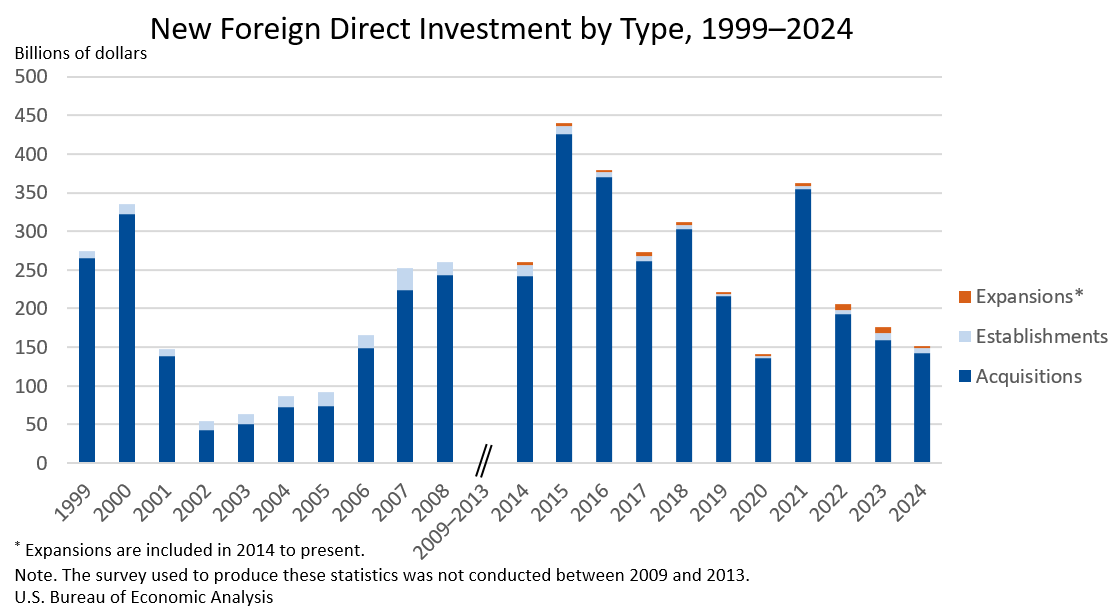Bureau of Economic Analysis
New Foreign Direct Investment in the United States, 2024
Expenditures by foreign direct investors to acquire, establish, or expand U.S. businesses totaled $151.0 billion in 2024, according to preliminary statistics released today by the U.S. Bureau of Economic Analysis. Expenditures decreased $24.9 billion, or 14.2 percent, from $176.0 billion (revised) in 2023 and were below the annual average of $277.2 billion for 2014–2023. As in previous years, acquisitions of existing U.S. businesses accounted for most of the expenditures.
Principal Federal Economic Indicators
Noteworthy
- 2025 News Release Schedule
- Innovation at BEA
- 2025 Annual Updates
- New! Services Trade Data for More Countries
- Data Tool: Trade in Value Added
- Distribution of State Personal Income
- Updated: RIMS II Regional Multipliers
- Arts and Culture
- Space Economy
- FDI Now in State BEARFACTS
- Quick Guide: Price Indexes
The Latest
Personal Income and Outlays, August 2010
Personal income increased $59.3 billion, or 0.5 percent, and disposable personal income (DPI) increased $52.0 billion, or 0.5 percent, inAugust, according to the Bureau of Economic Analysis. Personal consumption expenditures (PCE) increased $41.3 billion, or 0.4 percent.
Gross Domestic Product, 2nd quarter 2010 (third estimate); Corporate Profits, 2nd quarter 2010 (revised estimate)
Real gross domestic product -- the output of goods and services produced by labor and property located in the United States -- increased at an annual rate of 1.7 percent in the second quarter of 2010, (that is, from the first quarter to the second quarter), according to the "third" estimate released by the Bureau of Economic Analysis. In the first quarter, real GDP increased 3.7 percent. The GDP estimate released today is based…
Travel and Tourism Satellite Accounts, 2nd quarter 2010
QUARTERLY TOURISM ESTIMATES WILL NOT BE DISCONTINUED (SEE THE BOX NEXT RELEASE)
-->
-->
Real spending on travel and tourism increased at an annual rate of 3.0 percent in 2010:2, following an increase of 5.0 percent (revised) in 2010:1. By comparison, real gross domestic product (GDP) increased 1.6 percent (second estimate) in 2010:2 after increasing 3.7 percent in 2010:1. Travel and tourism prices…
State Quarterly Personal Income, 1st quarter 2007-2nd quarter 2010; State Annual Personal Income, 2007-2009 (revised estimate)
WASHINGTON DC, September 20, 2010 - State personal income growth averaged 1.0 percent in the second quarter of 2010 up slightly from 0.9 percent in the first quarter, according to estimates released today by the U.S. Bureau of Economic Analysis. Growth rates ranged from 2.0 percent in North Dakota to 0.3 percent in Nevada. There was no change in the national price index for personal consumption expenditures in the second quarter; inflation…
U.S. International Transactions, 2nd quarter 2010
NOTE: See the navigation bar at the right side of the news release text for links to data tables, contact personnel and their telephone numbers, and supplementary materials.
Sarah Scott Thomas: (202) 606-9286
Personal Income and Outlays, July 2010
Personal income increased $30.0 billion, or 0.2 percent, and disposable personal income (DPI) increased $17.6 billion, or 0.2 percent, inJuly, according to the Bureau of Economic Analysis. Personal consumption expenditures (PCE) increased $44.1 billion, or 0.4 percent.
Gross Domestic Product, 2nd quarter 2010 (second estimate); Corporate Profits, 2nd quarter 2010 (preliminary estimate)
Real gross domestic product -- the output of goods and services produced by labor and property located in the United States -- increased at an annual rate of 1.6 percent in the second quarter of 2010, (that is, from the first quarter to the second quarter), according to the "second" estimate released by the Bureau of Economic Analysis. In the first quarter, real GDP increased 3.7 percent. The GDP estimates released today are based on more…
Personal Income for Metropolitan Areas, 2009
WASHINGTON DC, August 9, 2010 – Personal income declined in 2009 in most of the nation's metropolitan statistical areas (MSAs), according to estimates released today by the U.S. Bureau of Economic Analysis. Personal income declined in 223 MSAs, increased in 134, and remained unchanged in 9 MSAs. On average, MSA personal income fell 1.8 percent in 2009, after rising 2.7 percent in 2008. Personal income growth ranged from 14 percent in…




